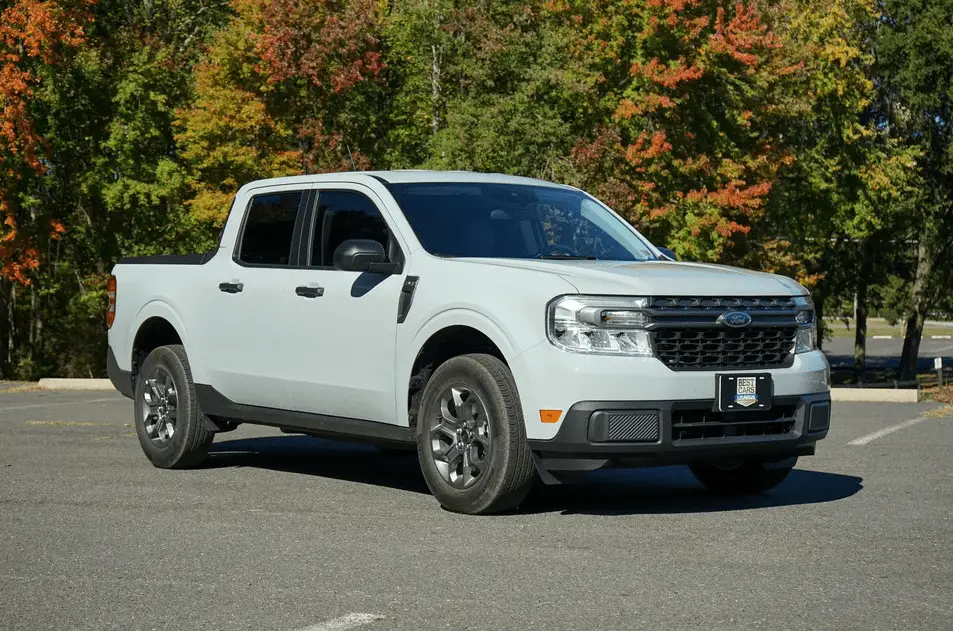
2024 FORD Maverick Engine Oil and Fluid User Guide
The suggested engine oil and other necessary fluids for the 2024 Ford Maverick will be covered in this tutorial. Learn the best techniques, specifications, and maintenance advice to guarantee your car’s longevity and optimum performance.
2024 Ford Maverick Specs, Price, Features, Mileage and Review
Video: 2024 FORD Maverick Engine Oil and Fluid
FORD ENGINE OIL Guide
ENGINE OIL DIPSTICK OVERVIEW
- Minimum.
- Nominal.
- Maximum.
CHECKING THE ENGINE OIL LEVEL
- Make sure that your vehicle is on level ground.
- Check the oil level before starting the engine, or switch the engine off after warming up and wait 10 minutes for the oil to drain into the oil pan.
- Remove the dipstick and wipe it with a clean, lint-free cloth.
- Reinstall the dipstick and make sure it is fully seated.
- Remove the dipstick again to check the oil level.Note
If the oil level is between the maximum and minimum marks, the oil level is acceptable. Do not add oil. - If the oil level is at the minimum mark, immediately add oil.
- Reinstall the dipstick. Make sure it is fully seated.
Note
The oil consumption of new engines reaches its normal level after approximately 3,000 mi (5,000 km).
ADDING ENGINE OIL
WARNING
Do not remove the filler cap when the engine is running.
WARNING
Do not add engine oil when the engine is hot. Failure to follow this instruction could result in personal injury.
Do not use supplemental engine oil additives because they are unnecessary and could lead to engine damage that the vehicle warranty may not cover.
- Clean the area surrounding the engine oil filler cap before you remove it.
- Remove the engine oil filler cap.
- Add engine oil that meets our specifications. See Capacities and Specifications.
- Reinstall the engine oil filler cap. Turn it clockwise until you feel a strong resistance.
Note
Do not add oil further than the maximum mark. Oil levels above the maximum mark may cause engine damage.
Note
Immediately soak up any oil spillage with an absorbent cloth.
RESETTING THE ENGINE OIL CHANGE REMINDER
Use the information display controls on the steering wheel to reset the oil change reminder.
ENGINE OIL CAPACITY AND SPECIFICATION
For filling information, please refer to the Capacities and Specifications section of your owner’s manual. See Engine Oil Capacity and Specification.
CHECKING THE COOLANT
When the engine is cold, check the concentration and level of the coolant at the intervals listed in the scheduled maintenance information. See Scheduled Maintenance.
Note
Make sure that the coolant level is between the minimum and maximum marks on the coolant reservoir.
Note
Coolant expands when it is hot. The level may extend beyond the MAX mark. If the coolant level is at or below the minimum mark, add prediluted coolant immediately. Maintain coolant concentration within 48% to 50%, which equates to a freeze point between -29°F (-34°C) and -35°F (-37°C). Coolant concentration should be checked using a refractometer. We do not recommend the use of hydrometers or coolant test strips for measuring coolant concentration.
Adding Coolant
WARNING
Do not remove the coolant reservoir cap when the engine is on or the cooling system is hot. Wait 10 minutes for the cooling system to cool down. Cover the coolant reservoir cap with a thick cloth to prevent the possibility of scalding and slowly remove the cap. Failure to follow this instruction could result in personal injury.
WARNING
Do not add engine coolant when the engine is on or the cooling system is hot. Failure to follow this instruction could result in personal injury.
WARNING
Do not add coolant further than the MAX mark.
WARNING
Do not put coolant in the windshield washer reservoir. If sprayed on the windshield, coolant could make it difficult to see through the windshield.
Note
Do not use stop leak pellets, cooling system sealants, or non-specified additives as they can cause damage to the engine cooling or heating systems. Resulting component damage may not be covered by the vehicle Warranty.
Note
Automotive fluids are not interchangeable. It is very important to use prediluted coolant approved to the correct specification in order to avoid plugging the small passageways in the engine cooling system. See Capacities and Specifications (page 355). Do not mix different colors or types of coolant in your vehicle. Mixing of engine coolants or using an incorrect coolant may harm the engine or cooling system components and could void the vehicle Warranty.
Note
If prediluted coolant is not available, use the approved concentrated coolant diluting it to 50/50 with deionized or distilled water. See Capacities and Specifications (page 355). Using water that has not been deionized may contribute to deposit formation, corrosion and plugging of the small cooling system passageways.
To top up the coolant level do the following:
- Unscrew the cap slowly. Any pressure escapes as you unscrew the cap.
- Add enough prediluted coolant to reach the correct level.
Note
We do not recommend the use of recycled coolant. - Replace the coolant reservoir cap. Turn the cap clockwise until it contacts the hard stop.
- Check the coolant level in the coolant reservoir the next few times you drive your vehicle. If necessary, repeat step 2.
If you have to add more than 1.1 qt (1 L) of engine coolant per month, have your vehicle checked as soon as possible. Operating an engine with a low level of coolant can result in engine overheating and possible engine damage.
In case of emergency, you can add a large amount of water without engine coolant in order to reach a vehicle service location. Service your vehicle as soon as possible. Water alone, without engine coolant, can cause engine damage from corrosion, overheating or freezing. Do not use the following as a coolant substitute, as they can cause engine damage from overheating or freezing:
- Alcohol.
- Methanol.
- Brine.
- Any coolant mixed with alcohol or methanol antifreeze.
Do not add extra inhibitors or additives to the coolant. These can be harmful and compromise the corrosion protection of the coolant.
Severe Climates
If you drive in extremely cold climates, you may need to increase the coolant concentration above 50%.
Note
A coolant concentration of 60%provides improved freeze point protection. Coolant concentrations above 60%decrease the overheat protection characteristics of the coolant and could cause engine damage.
If you drive in extremely hot climates, you may need to decrease the coolant concentration to 40%.
Note
A coolant concentration of 40%provides improved overheat protection. Coolant concentrations below 40%decrease the overheat and corrosion protection characteristics of the coolant and could cause engine damage.
Coolant Change
Change the coolant at specific mileage intervals. Refer to the scheduled maintenance information. See Normal Scheduled Maintenance.
Note
Dispose of used coolant in the appropriate manner. Follow your community’s regulations and standards for recycling and disposing of automotive fluids.
Fail-Safe Cooling
Fail-safe cooling allows you to temporarily drive your vehicle before any incremental component damage occurs. The fail-safe distance depends on ambient temperature, vehicle load and terrain.
How Fail-Safe Cooling Works If the engine begins to overheat, the coolant temperature gauge moves toward the red zone:
If the engine begins to overheat, the coolant temperature gauge moves toward the red zone:
![]() A warning lamp illuminates and a message may appear in the information display.
A warning lamp illuminates and a message may appear in the information display.
If the engine reaches a preset over-temperature condition, the engine automatically switches to alternating cylinder operation. Each disabled cylinder acts as an air pump and cools the engine. When this occurs, your vehicle still operates, however:
- Engine power is limited.
- The air conditioning system turns off.
Continued operation increases the engine temperature, causing the engine to completely shut down. Your steering and braking effort increases in this situation. When the engine temperature cools, you can re-start the engine. Have your vehicle checked as soon as possible to minimize engine damage.
When Fail-Safe Mode Is Activated
WARNING
Fail-safe mode is for use during emergencies only. Operate your vehicle in fail-safe mode only as long as necessary to bring your vehicle to rest in a safe location and seek immediate repairs. When in fail-safe mode, your vehicle will have limited power, will not be able to maintain high-speed operation, and may completely shut down without warning, potentially losing engine power, power steering assist, and power brake assist, which may increase the possibility of a crash resulting in serious injury.
WARNING
Do not remove the coolant reservoir cap when the engine is on or the cooling system is hot. Wait 10 minutes for the cooling system to cool down. Cover the coolant reservoir cap with a thick cloth to prevent the possibility of scalding and slowly remove the cap. Failure to follow this instruction could result in personal injury.
2024 Ford Maverick Specs, Price, Features, Mileage and Review
Your vehicle has limited engine power when in the fail-safe mode, drive your vehicle with caution. Your vehicle does not maintain high-speed operation and the engine could operate poorly.
Remember that the engine is capable of automatically shutting down to prevent engine damage. In this situation:
- Pull off the road as soon as safely possible and switch the engine off.
- If you are a member of a roadside assistance program, we recommend that you contact your roadside assistance service provider.
- If this is not possible, wait for a short period of time for the engine to cool.
- Check the coolant level. If the coolant level is at or below the minimum mark, add prediluted coolant immediately.
- When the engine temperature cools, you can re-start the engine. Have your vehicle checked as soon as possible to minimize engine damage.
ADDING WASHER FLUID
- Remove the washer fluid reservoir cap.
- Add washer fluid that meets our specification. See Washer Fluid Specification.
- Install the washer fluid reservoir cap.
Note
The reservoir supplies the front and rear washer systems.
WASHER FLUID SPECIFICATION
See Washer Fluid Specification
Useful Links:
View Full PDF: 2024 FORD Maverick Owner’s Manual|Auto User Guide
2024 Ford Maverick Specs, Price, Features, Mileage and Review
2024 FORD Maverick Wipers and Washers Guide

